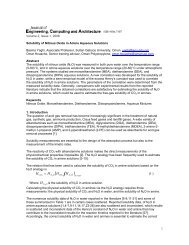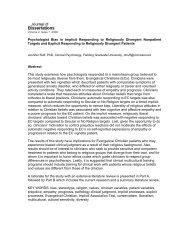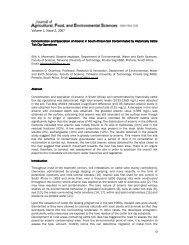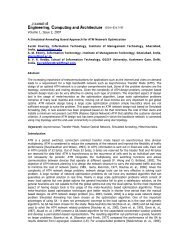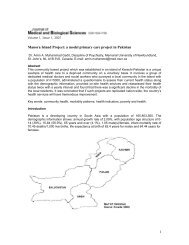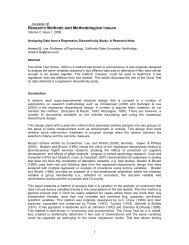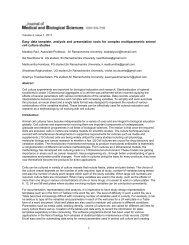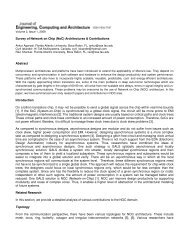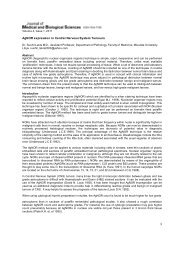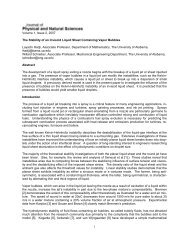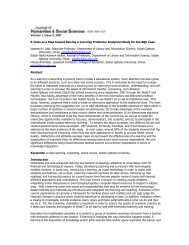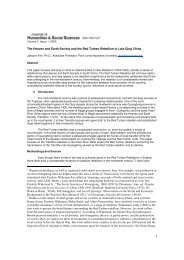How did blood transfusion in Britain work during WWII and its ...
How did blood transfusion in Britain work during WWII and its ...
How did blood transfusion in Britain work during WWII and its ...
You also want an ePaper? Increase the reach of your titles
YUMPU automatically turns print PDFs into web optimized ePapers that Google loves.
Volume 2, Issue 1, 2008<br />
<strong>How</strong> <strong>did</strong> <strong>blood</strong> <strong>transfusion</strong> <strong>in</strong> Brita<strong>in</strong> <strong>work</strong> dur<strong>in</strong>g <strong>WWII</strong> <strong>and</strong> <strong>its</strong> significance<br />
Sreedhar Krishna, Student, Faculty of Medic<strong>in</strong>e, Imperial College London, skk04@imperial.ac.uk<br />
Abstract<br />
The process of <strong>blood</strong> <strong>transfusion</strong> has ga<strong>in</strong>ed credibility s<strong>in</strong>ce early, <strong>and</strong> often, lethal experiments with<br />
fluids. This project discusses how <strong>transfusion</strong> evolved with<strong>in</strong> the first half of the 20 th century from a<br />
perceived ‘encumbrance’ to an <strong>in</strong>valuable resource. As war has punctuated this period, wartime<br />
necessity is often misconstrued as the sole stimulus for medical <strong>in</strong>novation. Exist<strong>in</strong>g accounts portray<br />
military medic<strong>in</strong>e as be<strong>in</strong>g characterised by radical wartime breakthroughs, punctuated by periods of<br />
relative stasis dur<strong>in</strong>g peacetime. Instead, this paper suggests that military medic<strong>in</strong>e simply reflects<br />
civilian practice, albeit with a different hierarchy of priorities. This essay will show that war <strong>did</strong> not<br />
stimulate technological <strong>in</strong>novation, but merely necessitated the implementation of exist<strong>in</strong>g<br />
technologies, sometimes at an experimental stage. Draw<strong>in</strong>g on m<strong>in</strong>utes of wartime meet<strong>in</strong>gs <strong>and</strong><br />
contemporary medical journals, this essay argues that war preparations synthesised an organised<br />
donor panel <strong>and</strong> improved the logistics of <strong>blood</strong> transport but <strong>did</strong> not directly improve cl<strong>in</strong>ical<br />
medic<strong>in</strong>e. Furthermore, this essay explores how <strong>in</strong>cremental progress <strong>in</strong> wartime can be partially<br />
attributed to the liberalised flow of <strong>in</strong>formation.<br />
Introduction<br />
“If red <strong>blood</strong> cells were a new drug today, it would be very difficult to get it licensed.”<br />
Dr. Jeffrey McCullough<br />
Blood <strong>transfusion</strong> is often listed, along with antisepsis <strong>and</strong> anaesthesia, as one of the key <strong>in</strong>novations<br />
that enabled medical treatment to keep up with the technological advances <strong>in</strong> military warfare’s ability<br />
to kill or maim. 1 As early as the ancient Greek idea of <strong>blood</strong> as a humour, <strong>blood</strong> was recognised as<br />
the bearer of life, carry<strong>in</strong>g <strong>its</strong> ‘vital spirit’ throughout the body. Loss of <strong>blood</strong> was known to lead to<br />
death, yet it took Western medic<strong>in</strong>e a long time to equate the replacement of <strong>blood</strong> with the sav<strong>in</strong>g of<br />
life. 2<br />
World War II brought destruction <strong>and</strong> death on an unprecedented scale, thereby provok<strong>in</strong>g a<br />
consequent medical response, characterised by Cooter as the ‘medical goodness of war’. 3 While<br />
other wartime advances (such as orthopaedic surgery <strong>and</strong> shellshock) have been traced <strong>in</strong> detail,<br />
there is a conspicuous lack of coverage on <strong>blood</strong> <strong>transfusion</strong>.<br />
Curiosity over <strong>blood</strong> has led to many attempts to replace <strong>blood</strong> with various fluids via numerous<br />
techniques. Most of these were fruitless (<strong>and</strong> often deadly) but by the outbreak of WWI there were<br />
doctors <strong>in</strong> many Western countries extoll<strong>in</strong>g the miraculous properties of <strong>blood</strong> <strong>transfusion</strong>.<br />
L<strong>and</strong>ste<strong>in</strong>er’s crucial discovery of <strong>blood</strong> groups was made <strong>in</strong> 1901 4 with technology for <strong>blood</strong> storage<br />
conceived 13 years later. Unfortunately, these breakthroughs which would prove to be milestones <strong>in</strong><br />
haematology, were largely ignored by the British medical establishment. <strong>How</strong>ever, the reality of war<br />
necessitated that these exist<strong>in</strong>g technologies were implemented broadly <strong>and</strong> promptly.<br />
1<br />
Gabriel RA, Metz KS. A History of Military Medic<strong>in</strong>e (Westport, 1992). p. xiii<br />
2 Roux JP. Sang: Mythes, symboles et realités (Paris, 1988), p. 57<br />
3 Cooter R. “War <strong>and</strong> Modern Medic<strong>in</strong>e”, <strong>in</strong> Bynum WF, Porter R (eds.) Contemporary Encylopaedia of the History of<br />
Medic<strong>in</strong>e (London, 1993), p. 1536-73<br />
4 L<strong>and</strong>ste<strong>in</strong>er K. “Uber agglut<strong>in</strong>ationsersche<strong>in</strong>ungen normalen menschlichen blutes”, Kl<strong>in</strong>. Wschr 14 (1901) 1132-1134
Draw<strong>in</strong>g on a wide array of primary as well as secondary sources, I will argue that war <strong>did</strong> not<br />
especially stimulate <strong>in</strong>novation, rather it dem<strong>and</strong>ed the utilisation of exist<strong>in</strong>g technologies <strong>and</strong> via a<br />
process of trial-<strong>and</strong>-error, enhanced exist<strong>in</strong>g knowledge. Furthermore, war diffused these<br />
technologies efficiently <strong>in</strong> a culture of cooperation. I will go on to show that the greatest improvements<br />
<strong>in</strong> <strong>blood</strong> <strong>transfusion</strong> were the robust donor organisations <strong>and</strong> a meticulously planned logistic system.<br />
I beg<strong>in</strong> by outl<strong>in</strong><strong>in</strong>g the pre-<strong>WWII</strong> British <strong>blood</strong> ‘system’ <strong>and</strong> proceed to discuss the British<br />
preparations for <strong>WWII</strong>, contrast<strong>in</strong>g with those of the Germans, show<strong>in</strong>g how these led to their<br />
respective success <strong>and</strong> defeat. I emphasise the progression of Vaughan’s idea through the British<br />
bureaucracy <strong>and</strong> describe the organisation of the resultant product.<br />
Many modern accounts of military medic<strong>in</strong>e simply suggest that war stimulated <strong>in</strong>novation <strong>and</strong> that<br />
any improvements were borne out of wartime necessity. 5,6,7 I believe that these accounts neglect the<br />
fact that many perceived ‘wartime <strong>in</strong>novations’ have their orig<strong>in</strong>s firmly <strong>in</strong> peacetime. In summary,<br />
wartime, despite <strong>its</strong> own unique needs, tends to reflect civilian practice.<br />
The source material I have drawn upon <strong>in</strong>cludes first-h<strong>and</strong> accounts, m<strong>in</strong>utes of wartime meet<strong>in</strong>gs,<br />
contemporary medical journals, transcripts of <strong>in</strong>terviews as well as secondary sources <strong>in</strong>clud<strong>in</strong>g<br />
review articles. Primary sources, such as the journals of the day, enable one to see the picture as it<br />
was portrayed <strong>in</strong> <strong>its</strong> day, while m<strong>in</strong>utes of meet<strong>in</strong>gs provide an <strong>in</strong>sight <strong>in</strong>to the war preparations – a<br />
traditionally confidential area. Review articles <strong>and</strong> books which I have used have provided me with<br />
ideas <strong>and</strong> arguments but it is unfortunately easy to absorb their fallacies also.<br />
Before <strong>WWII</strong><br />
From the beg<strong>in</strong>n<strong>in</strong>g of the 20 th century to the end of WWI, there was a vast improvement <strong>in</strong> the<br />
underst<strong>and</strong><strong>in</strong>g of how to remove <strong>blood</strong> as well as how to <strong>in</strong>ject it safely. This advance was facilitated<br />
by the opportunity WWI provided to trial various <strong>transfusion</strong> protocols <strong>in</strong> situations where the<br />
prognosis was hopelessly poor. 8 The dem<strong>and</strong>s imposed by wartime casualties rendered <strong>transfusion</strong><br />
<strong>in</strong>dispensable <strong>and</strong> thus expertise was ga<strong>in</strong>ed. Moreover, the length of WWI meant that every possible<br />
promis<strong>in</strong>g protocol permutation could be tested without the fear of be<strong>in</strong>g br<strong>and</strong>ed unethical, thus<br />
establish<strong>in</strong>g the best techniques much quicker than would otherwise have been possible. Records<br />
show that <strong>transfusion</strong> became entrenched <strong>in</strong> military medic<strong>in</strong>e by the end of WWI 9 although <strong>its</strong><br />
frequency of use varied with location. 10<br />
Hav<strong>in</strong>g proven <strong>its</strong> value <strong>in</strong> the field, <strong>transfusion</strong> was perplex<strong>in</strong>gly ignored by civilian practitioners. The<br />
transition from WWI to peace brought with it a reduced dem<strong>and</strong> for <strong>blood</strong>, but unfortunately it<br />
removed the impetus <strong>and</strong> urgency with which advances are made. It is often stated that total war<br />
requires a total commitment. 11 As such, the extraord<strong>in</strong>ary mobilisation of entire countries afforded<br />
doctors with a plentiful, motivated donor supply. Peacetime, conversely, brought with it an <strong>in</strong>hibitive<br />
<strong>in</strong>fluence on both <strong>blood</strong> dem<strong>and</strong> <strong>and</strong> supply.<br />
Moreover, peacetime brought new <strong>in</strong>dications for <strong>transfusion</strong>: Instead of be<strong>in</strong>g used to treat wounded<br />
soldiers, the technology was utilised effectively <strong>in</strong> postpartum haemorrhage. <strong>How</strong>ever, the expertise<br />
ga<strong>in</strong>ed by British doctors was not transferred to civilian practice as it was not until 1926 that the British<br />
Medical Association held a conference on <strong>blood</strong> <strong>transfusion</strong>. 12<br />
5<br />
Samuels RJ. Rich Nation: Strong Army (Cornell University Press, 1996)<br />
6<br />
Daunton M. The Cambridge Urban History of Brita<strong>in</strong> (Cambridge University Press, 2001)<br />
7 Travers T. Men at War: Politics, Technology <strong>and</strong> Innovation <strong>in</strong> the 20 th Century (Chicago, 1981)<br />
8 Pelis K. “Tak<strong>in</strong>g Credit: The Canadian Army Medical Corps <strong>and</strong> the British Conversion to Blood Transfusion <strong>in</strong> WWI”<br />
Journal of History <strong>and</strong> Medical Allied Sciences 56 (2001), 238-277<br />
9 Interallied Surgical Conference on Transfusion. Arch. Med. Pharm. Mil. 70 (1918), 121-85<br />
10 Macpherson WG. Medical Services Surgery of the War (London, 1922) p. 108-133<br />
11 Shaw M. Dialectics of War: An Essay <strong>in</strong> the Social Theory of Total War <strong>and</strong> Peace (Pluto, 1987)<br />
12<br />
“Discussion on Blood Transfusion <strong>in</strong> the Treatment of Disease”, British Medical Journal ii. (1926) 969-83
Despite the paucity of <strong>in</strong>terest <strong>in</strong> <strong>transfusion</strong>, peacetime advances were made, but were not adopted<br />
as quickly as war might have forced otherwise. The rate of improvement rema<strong>in</strong>ed roughly constant,<br />
as can be attested to by Unger’s stopcock <strong>and</strong> the conception of citrate both hav<strong>in</strong>g their roots firmly<br />
<strong>in</strong> peacetime. 13 <strong>How</strong>ever, doctors’ ethical concerns over tamper<strong>in</strong>g with <strong>blood</strong> (which still reta<strong>in</strong>ed<br />
some allegorical mean<strong>in</strong>g) as well as mild fevers delayed the uptake of storage technology.<br />
Contrary to the common belief that <strong>in</strong>novation is borne out of wartime necessity, the anticoagulant<br />
application of citrate was discovered, <strong>in</strong>dependently, <strong>in</strong> Argent<strong>in</strong>a, Belgium <strong>and</strong> the US, dur<strong>in</strong>g 1914,<br />
<strong>in</strong>dicat<strong>in</strong>g that peacetime <strong>in</strong>terest <strong>in</strong> <strong>transfusion</strong> was sufficient to bear dividend. 14<br />
Civilian <strong>transfusion</strong> before <strong>WWII</strong> was a thoroughly haphazard affair. Doctors who needed <strong>blood</strong><br />
depended upon an unreliable donor supply, compris<strong>in</strong>g the patient’s family <strong>and</strong> personal net<strong>work</strong>.<br />
Percy Lane Oliver was confronted by this situation <strong>in</strong> London <strong>in</strong> 1921. As secretary of the Camberwell<br />
Division of the British Red Cross, he received a call urgently request<strong>in</strong>g <strong>blood</strong>. Hav<strong>in</strong>g no other<br />
sources of <strong>blood</strong> from which he could draw, he along with three colleagues rushed to the hospital, <strong>and</strong><br />
the patient survived. 15 This experience <strong>in</strong>spired Oliver: An established bureau of screened, pretested<br />
volunteers could save hundreds of lives by provid<strong>in</strong>g donors of various <strong>blood</strong> types with little notice.<br />
This was exactly what Oliver constructed, beg<strong>in</strong>n<strong>in</strong>g with his tentative twenty-strong <strong>in</strong>itial donor panel<br />
composed of professional acqua<strong>in</strong>tances. As news of his <strong>in</strong>novation grew, so <strong>did</strong> his panel size <strong>and</strong><br />
frequency of uptake by doctors. Dur<strong>in</strong>g <strong>its</strong> first year of operation, 1922, he was called only thirteen<br />
times. <strong>How</strong>ever, dur<strong>in</strong>g 1925 he fielded 428 calls from hospitals. 16 Hav<strong>in</strong>g tapped <strong>in</strong>to a precious<br />
resource which enjoyed grow<strong>in</strong>g dem<strong>and</strong>, he further exp<strong>and</strong>ed his donor base <strong>in</strong>to the YMCA <strong>and</strong><br />
Rover Scouts <strong>and</strong> established the world’s first municipal donor panel: the Greater London Red Cross<br />
Blood Transfusion Service. 17<br />
A significant proportion of the <strong>blood</strong> requests can be attributed to Dr. Geoffrey Keynes, one of the<br />
most prom<strong>in</strong>ent British surgeons of his period. Hav<strong>in</strong>g become familiar with sodium citrate, an<br />
effective anticoagulant, dur<strong>in</strong>g his <strong>work</strong> with American physicians he became a tireless proponent of<br />
the storage technology. Utilis<strong>in</strong>g <strong>blood</strong> <strong>transfusion</strong> to restore <strong>blood</strong> volume he “had the satisfaction of<br />
pull<strong>in</strong>g many men from the jaws of death”. 18 <strong>How</strong>ever upon return<strong>in</strong>g to civilian practice, he was<br />
deeply disappo<strong>in</strong>ted <strong>in</strong> the attitudes of his peers towards <strong>transfusion</strong> who regarded it as an<br />
encumbrance. The general nature of the British medical establishment’s <strong>in</strong>difference to <strong>blood</strong> <strong>and</strong> <strong>its</strong><br />
use as a therapeutic tool rema<strong>in</strong>s a recurr<strong>in</strong>g theme up until just before the outbreak of <strong>WWII</strong>.<br />
Moreover, despite Keynes’s early advocation of citrate technology 19 , this technology was completely<br />
ignored for almost 20 years <strong>in</strong> the UK, thereby restrict<strong>in</strong>g <strong>blood</strong> to immediate use <strong>and</strong> direct<br />
<strong>transfusion</strong>s – otherwise known as “donors-on-the-hoof.”<br />
Blood <strong>in</strong> 1912 was the same <strong>blood</strong> which coursed through ve<strong>in</strong>s <strong>in</strong> 1915; however, war drew upon<br />
different facets of the same life-sav<strong>in</strong>g fluid. Research on <strong>blood</strong> had established the presence of <strong>blood</strong><br />
groups at the beg<strong>in</strong>n<strong>in</strong>g of the 20 th century yet the risk of agglut<strong>in</strong>ation due to <strong>blood</strong> <strong>in</strong>compatibility<br />
was ignored. 20 Just as would be seen with the uptake of citrate technology, the context <strong>and</strong> needs of<br />
war <strong>in</strong>fluenced <strong>blood</strong> typ<strong>in</strong>g. The primary impedant to rout<strong>in</strong>e <strong>blood</strong> typ<strong>in</strong>g was the time needed to<br />
conduct the tests, which was rarely available <strong>in</strong> the immediately life-threaten<strong>in</strong>g war casualties. The<br />
13 Robertson OH. “Transfusion with Preserved Red Blood Cells”, British Medical Journal i. (1918) 691-95<br />
14<br />
Maluf NSR. “History of Blood Transfusion”, Journal of the History of Medic<strong>in</strong>e 9 (1954) 59-109<br />
15<br />
British Red Cross Society. Report of the Blood Transfusion Service for the Year Ended Dec. 31 st , 1926 (London: Petley<br />
& Co. Pr<strong>in</strong>ters) p. 5-9<br />
16 British Red Cross Society. Report of the Blood Transfusion Service for the Year Ended Dec. 31 st , 1926 (London: Petley<br />
& Co. Pr<strong>in</strong>ters) p. 4<br />
17 Proger, L. W. “Development of the Emergency Blood Transfusion Scheme”, British Medical Journal 2 (1942) 252-253<br />
18 Keynes G. The Gates of Memory (Oxford: Clarendon Press, 1981), p. 144<br />
19 Conference on Shock <strong>and</strong> Transfusion, 25 May 1945.<br />
20<br />
Smekal F, Speiser P. Karl L<strong>and</strong>ste<strong>in</strong>er trans. Richard Rickett. (Vienna, 1975)
tales of <strong>blood</strong> typ<strong>in</strong>g <strong>and</strong> sodium citrate <strong>in</strong>terweave, s<strong>in</strong>ce if citrate were used, then the <strong>blood</strong> could<br />
have been tested <strong>and</strong> typed prior to use, but alas this was not the case.<br />
Despite surgeons’ ambivalence towards these two technologies, advice on <strong>blood</strong> typ<strong>in</strong>g <strong>and</strong><br />
admonition to follow it grew <strong>in</strong>creas<strong>in</strong>gly prom<strong>in</strong>ent <strong>in</strong> post-WWI medical literature. British doctors,<br />
who were once <strong>in</strong>different to <strong>blood</strong> typ<strong>in</strong>g, were spurred on by their experiences to dem<strong>and</strong> faster <strong>and</strong><br />
simpler mechanisms of <strong>blood</strong> typ<strong>in</strong>g. With the <strong>in</strong>creased visibility afforded to it, a <strong>blood</strong> typ<strong>in</strong>g test was<br />
soon developed <strong>and</strong> heralded by British surgeons: “The test is so simple, precise <strong>and</strong> rapid that no<br />
excuse is valid for <strong>its</strong> omission.” 21<br />
Blood <strong>and</strong> Germany<br />
555 miles from Camberwell, <strong>in</strong> Niederlungwitz, Germany, a physician encountered a patient with an<br />
urgent need for <strong>blood</strong>. Without any available donors, he cut <strong>in</strong>to his own arm <strong>and</strong> donated his own<br />
<strong>blood</strong> which happened to be compatible. This act of quiet heroism was not heralded as such s<strong>in</strong>ce Dr.<br />
Serelman, a Jew, had donated <strong>blood</strong> to an Aryan. As punishment for “defil<strong>in</strong>g the <strong>blood</strong> of the<br />
German race” he was sent to a concentration camp for six months. 22<br />
German medical research, renowned for <strong>its</strong> rigorous st<strong>and</strong>ards <strong>and</strong> advanced nature, fell backward<br />
<strong>in</strong>to myth <strong>and</strong> superstition. Under the Nazi regime, <strong>blood</strong> was not only a life-sav<strong>in</strong>g resource but had<br />
ga<strong>in</strong>ed some symbolic status: A resource signify<strong>in</strong>g the racial purity that could be used as ‘scientific’<br />
justification for Aryan superiority. 23,24 Furthermore, the Nazis had conducted a systematic cleans<strong>in</strong>g of<br />
the “Jewish <strong>in</strong>fluence” from medic<strong>in</strong>e, 25 which culm<strong>in</strong>ated <strong>in</strong> the triumphant declaration, “No man of<br />
German <strong>blood</strong> is treated by a German doctor”. 26,27 <strong>How</strong>ever, the allegorical mean<strong>in</strong>g attributed to<br />
<strong>blood</strong> by the Nazis, supplemented by the removal of Jewish doctors, would prove to be a horrendous<br />
tactical error. By remov<strong>in</strong>g many of their most learned doctors, the Nazis had created a knowledge<br />
vacuum which was filled by quackery <strong>and</strong> folk remedies. 28 Tra<strong>in</strong><strong>in</strong>g of new Aryan students could not<br />
suffice for Germany’s wartime needs <strong>and</strong> the Nazis rapidly backpedalled, order<strong>in</strong>g the remobilisation<br />
of Jewish doctors. Their cleans<strong>in</strong>g, however, had proved too effective <strong>and</strong> this would eventually prove<br />
self-defeat<strong>in</strong>g <strong>in</strong> the field.<br />
Furthermore, Nazi racial theories killed many of those who believed them, for many “Germans refused<br />
<strong>blood</strong> <strong>transfusion</strong> for fear that non-Aryan <strong>blood</strong> might be poured <strong>in</strong>to them to poison them”. This is <strong>in</strong><br />
contrast to the rational perspective taken by the British, frankly illustrated by a statement issued to the<br />
British public to encourage donation, “The reality is this. Your <strong>blood</strong>, properly poured <strong>in</strong>to a sick or<br />
wounded man’s ve<strong>in</strong>s may be his one chance of life, <strong>and</strong> on the other h<strong>and</strong> may mean certa<strong>in</strong> death<br />
for him.”<br />
Dame Janet Vaughan<br />
London was at peace <strong>in</strong> the spr<strong>in</strong>g <strong>and</strong> summer of 1939, although there was a general admission that<br />
war with Germany was <strong>in</strong>evitable. As such, the solidarity conferred by a common enemy <strong>and</strong><br />
impend<strong>in</strong>g attack was nicely demonstrated by banners proclaim<strong>in</strong>g “Be proud of our glorious empire.”<br />
In the likely eventuality of war, government <strong>in</strong>telligence estimates projected that the German air force<br />
could drop 1200 tonnes of bombs with<strong>in</strong> the first 24 hours alone, followed by a susta<strong>in</strong>ed bomb<strong>in</strong>g of<br />
600 tonnes a day. Clearly, bomb<strong>in</strong>g of this ferocity comb<strong>in</strong>ed with the population density of British<br />
21 Crile GW. George Grile: An Autobiography (Philadelphia, 1947) p. 164-7<br />
22<br />
“Dr. Serelman Says Transfusion Can’t Alter Race”, New York Times, Oct. 20, 1935.<br />
23<br />
Mazumdar MH. “Blood <strong>and</strong> the Soil: The Serology of the Aryan Racial State”, Bullet<strong>in</strong> of the History of Medic<strong>in</strong>e 64<br />
(1990) 209<br />
24 Schneider WH. Chance <strong>and</strong> Social Sett<strong>in</strong>g <strong>in</strong> the Application of the Discovery of Blood Groups. Bullet<strong>in</strong> of the<br />
History of Medic<strong>in</strong>e 57 (1983) 545-62<br />
25 Coleman W. The Physician <strong>in</strong> Nazi Germany. Bullet<strong>in</strong> of the History of Medic<strong>in</strong>e 60 (1986) 236.<br />
26 Proctor R. Racial Hygiene: Medic<strong>in</strong>e under the Nazis (Harvard University Press, 1988) p. 150<br />
27 Lifton RJ. The Nazi Doctors: Medical Kill<strong>in</strong>g <strong>and</strong> the Psychology of Genocide (Basic Books, 1986)<br />
28<br />
Coleman W. The Physician <strong>in</strong> Nazi Germany. Bullet<strong>in</strong> of the History of Medic<strong>in</strong>e 60 (1986): pp. 236-7
cities would result <strong>in</strong> a catastrophic death-toll. Fortunately, the prediction of 600,000 civilian deaths<br />
was somewhat pessimistic.<br />
In preparation for this Doomsday scenario, the government made robust preparations: Thous<strong>and</strong>s of<br />
gas masks, or “ ‘Itlers,” as they were colloquially referred to, were provided. The civilian population<br />
was mobilised to serve as bomb spotters, air raid wardens <strong>and</strong> firefighters amongst many other vital<br />
roles. Public swimm<strong>in</strong>g pools were emptied to store makeshift papier-mâché coff<strong>in</strong>s, <strong>and</strong> volum<strong>in</strong>ous<br />
p<strong>its</strong> were dug to serve as mass graves. Surpris<strong>in</strong>gly, <strong>in</strong> preparation for such terrible <strong>blood</strong>shed, the<br />
British were naïve <strong>in</strong> their <strong>blood</strong> <strong>transfusion</strong> policy.<br />
As mentioned earlier, London still relied on donors-on-the-hoof, a scarcely adequate mechanism<br />
dur<strong>in</strong>g peacetime which would be utterly swamped <strong>in</strong> the first days of any conflict. Hav<strong>in</strong>g no impetus<br />
to ga<strong>in</strong> expertise <strong>in</strong> this sector, the British medical establishment, like many others worldwide, learned<br />
little of the pioneer<strong>in</strong>g technologies that would enable <strong>blood</strong> storage <strong>in</strong> bottles. In 1937, dur<strong>in</strong>g a<br />
hear<strong>in</strong>g on wartime preparations the Secretary of War was asked about the nation’s proposed <strong>blood</strong><br />
supply <strong>in</strong> wartime. He summarised the government’s policy was “not to store <strong>blood</strong> for large scale<br />
treatment,” attribut<strong>in</strong>g this to the erroneous notion “[that the] period for which this can be done is very<br />
limited.” 29 Sens<strong>in</strong>g the m<strong>in</strong>ister’s falter<strong>in</strong>g knowledge of current research, an MP asked the m<strong>in</strong>ister if<br />
he was aware that the Russians were stockpil<strong>in</strong>g <strong>blood</strong> <strong>in</strong> bottles for extended periods. Reiterat<strong>in</strong>g his<br />
faith <strong>in</strong> donors-on-the-hoof, the m<strong>in</strong>ister curtly <strong>and</strong> somewhat humorously replied “It was more<br />
satisfactory to store our <strong>blood</strong> <strong>in</strong> our people.” Complacency, it seems was not restricted to this<br />
m<strong>in</strong>ister, rather it was almost uniformly dissem<strong>in</strong>ated throughout the London medical establishment.<br />
Shock<strong>in</strong>gly, <strong>in</strong> response to the 1938 prediction by the M<strong>in</strong>istry of Health of 37,000 casualties dur<strong>in</strong>g<br />
the first week of war, the staff at four hospitals stockpiled a gr<strong>and</strong> total of eight p<strong>in</strong>ts. 30<br />
Thus stepped <strong>in</strong>to the breach, the one person with the prescience <strong>and</strong> courage to challenge the<br />
assured nature of the status quo: Dame Janet Vaughan. Dr. Vaughan, as she was known then, was a<br />
young pathologist at the Royal Postgraduate Medical School <strong>and</strong> Hammersmith Hospital <strong>in</strong> London.<br />
Described by Virg<strong>in</strong>ia Woolf as “an attractive woman” 31 <strong>and</strong> dismissed by her school headmistress as<br />
“too stupid to justify further education,” 32 she sought to shatter the Girton girl stereotype 33 <strong>and</strong> went on<br />
to receive a medical degree from Oxford. Unfortunately, <strong>in</strong> keep<strong>in</strong>g with societal norms of the time she<br />
found that her superiors would not allow her to <strong>in</strong>teract with their patients, <strong>and</strong> thus was restricted to<br />
conduct<strong>in</strong>g laboratory experiments with pigeons. Nevertheless, she excelled <strong>in</strong> this arena <strong>and</strong> made<br />
significant contributions to the study of anaemia writ<strong>in</strong>g the first British textbook on <strong>blood</strong> chemistry.<br />
Dur<strong>in</strong>g her residency at Camden Town, she had seen the <strong>in</strong>equalities of the British class system firsth<strong>and</strong><br />
<strong>and</strong> vowed to correct them. Spurred on by what she had seen, she jo<strong>in</strong>ed the Communist Party<br />
<strong>and</strong> took part <strong>in</strong> a British physicians’ group that supported the Republicans <strong>in</strong> the Spanish Civil War.<br />
In a fortuitous twist of fate, it was dur<strong>in</strong>g this endeavour that she became familiar with Duran-Jorda<br />
<strong>and</strong> became conv<strong>in</strong>ced that the Secretary of War’s position was folly.<br />
Testament to her determ<strong>in</strong>ation <strong>and</strong> perseverance, she almost s<strong>in</strong>gle-h<strong>and</strong>edly established her own<br />
m<strong>in</strong>i ‘<strong>blood</strong> depot’ <strong>in</strong> 1938 as a response to Hitler’s repeated threats of <strong>in</strong>vasion. Vaughan <strong>and</strong> a<br />
colleague from the Hammersmith Hospital collected 50 bottles of <strong>blood</strong> from volunteers, successfully<br />
preserv<strong>in</strong>g them with sodium citrate. Although 50 bottles may sound a meagre figure, it is important to<br />
remember that this was achieved by an isolated strong-willed pathologist <strong>and</strong> yet it was the largest<br />
<strong>blood</strong> storage <strong>in</strong> the whole of London at the time. After the Munich pact was signed <strong>and</strong> the crisis<br />
abated, the stored <strong>blood</strong> was successfully used <strong>in</strong> patients; develop<strong>in</strong>g <strong>in</strong> Vaughan an unshakeable<br />
confidence <strong>in</strong> this technology.<br />
29<br />
Masson AHB. History of the Blood Transfusion Service <strong>in</strong> Ed<strong>in</strong>burgh, p.24.<br />
30 Masson AHB. History of the Blood Transfusion Service <strong>in</strong> Ed<strong>in</strong>burgh, p.24.<br />
31 Adams P. Janet Maria Vaughan, 1899-1993: A Memorial Tribute<br />
32 Dodsworth H. Dame Janet Vaughan, p.31<br />
33<br />
Allen G. The Woman Who Did (Kess<strong>in</strong>ger, 2001)
Vaughan realised that a city under aerial bombardment would make the donors-on-the-hoof system<br />
un<strong>work</strong>able. She had the foresight to recognise that doctors <strong>in</strong>volved <strong>in</strong> emergency surgery would not<br />
be able to bleed donors <strong>and</strong> had the courage to say so. In a lecture to the Postgraduate Medical<br />
School, she argued “They must adm<strong>in</strong>ister <strong>blood</strong> <strong>and</strong> not spend time withdraw<strong>in</strong>g <strong>blood</strong>” 34 . Perhaps<br />
due to the stigma of an oversight be<strong>in</strong>g spotted by a woman, no action was taken by the Health<br />
M<strong>in</strong>istry. After six months of <strong>in</strong>activity Vaughan’s patience wore th<strong>in</strong> <strong>and</strong> she <strong>in</strong>imitably swept <strong>in</strong>to<br />
action. In the spr<strong>in</strong>g of 1939, she convened a series of meet<strong>in</strong>gs of young doctors to discuss<br />
appropriate preparations for London. Although entirely unofficial, these meet<strong>in</strong>gs would formulate the<br />
backbone of the <strong>blood</strong> <strong>transfusion</strong> scheme of London. It was eventually agreed “to use milk bottles<br />
that would be readily available <strong>in</strong> large quantities <strong>and</strong> could be h<strong>and</strong>led <strong>in</strong> milk crates.” In another<br />
memorable example of the <strong>in</strong>genuity required by war, they decided that Wall’s ice-cream trucks would<br />
provide suitable transport.<br />
Two pioneer<strong>in</strong>g foreigners would <strong>in</strong>spire the British <strong>blood</strong> <strong>transfusion</strong> system. The first of these,<br />
Norman Bethune, a self-described man of action <strong>and</strong> surgeon, recognised the <strong>in</strong>efficiency of current<br />
protocol. He wondered ‘Why br<strong>in</strong>g the bleed<strong>in</strong>g men back to the hospital when the <strong>blood</strong> should travel<br />
forward to them?’ Thus, the progression from donors-on-the-hoof irrevocably started. 35 In the spirit of<br />
wartime cooperation, the efficient flow of <strong>in</strong>formation across borders would prove to be vital <strong>in</strong><br />
establish<strong>in</strong>g a robust British <strong>transfusion</strong> system.<br />
Dur<strong>in</strong>g the endgame of the Spanish Civil War, General Franco’s troops occupied Catalonia <strong>and</strong><br />
Duran-Jorda fled to the United K<strong>in</strong>gdom as an <strong>in</strong>vitee of Vaughan, on behalf of the British Red Cross.<br />
This <strong>in</strong>vitation was the only legal mechanism by which Duran-Jorda could enter the UK <strong>and</strong>, as such,<br />
he was one of a very small m<strong>in</strong>ority who were granted permission to stay. Resid<strong>in</strong>g with Vaughan’s<br />
family, he shared his significant expertise help<strong>in</strong>g shape the eventual proposal that would be<br />
submitted, unsolicited, to the Medical Research Council. 36,37,38<br />
They conceived a system <strong>in</strong>volv<strong>in</strong>g four depots situated around London, each staffed by a<br />
haematologist, stocked with <strong>blood</strong> <strong>and</strong> the necessary <strong>transfusion</strong> equipment. Amazed at the temerity<br />
of Vaughan <strong>and</strong> her <strong>in</strong>dependent plans, she was br<strong>and</strong>ed as “pretty naughty” by her department<br />
chairman. She recalled be<strong>in</strong>g questioned, “What was I do<strong>in</strong>g send<strong>in</strong>g memor<strong>and</strong>a to <strong>in</strong>fluential<br />
places?” 39 <strong>and</strong> duly apologised. Despite hav<strong>in</strong>g leapfrogged her superiors, the Medical Research<br />
Council recognised the value of her proposal <strong>and</strong> promptly requested cost estimates.<br />
Hav<strong>in</strong>g cleared this significant hurdle, the proposal was delayed for weeks by a Treasury M<strong>in</strong>istry that<br />
sought reassurance: “[We] cannot help feel<strong>in</strong>g that the proposals <strong>in</strong> your letter are rather expensive<br />
<strong>and</strong> we should like to be assured that they represent the absolute m<strong>in</strong>imum cost.” 40 <strong>How</strong>ever, the<br />
glow<strong>in</strong>g recommendation of Health M<strong>in</strong>istry officials provided the f<strong>in</strong>al weight, tipp<strong>in</strong>g the balance <strong>and</strong><br />
the project was given the green light on June 5, 1939.<br />
Under the circumstances of war, fund<strong>in</strong>g plays a vital role. Money that would ord<strong>in</strong>arily be spent on<br />
civilian <strong>in</strong>frastructure <strong>and</strong> services are <strong>in</strong>stead diverted <strong>in</strong>to the direct needs of war (e.g. weaponry<br />
<strong>and</strong> military logistics). Thus, Vaughan was forced to adapt creatively <strong>in</strong> her use of available materials<br />
as demonstrated by the milk bottle, also termed the “MRC bottle” or more affectionately, the “Janet<br />
Vaughan.” In the tight-squeeze of war, the Treasury balked at the estimation that the £20,000 scheme<br />
34 Vaughan JM. “War Wounds <strong>and</strong> Air Raid Casualties”, British Medical Journal (1939) 933-36<br />
35<br />
Stewart R. The M<strong>in</strong>d of Norman Bethune (Westport, 1977)<br />
36<br />
Duran-Jorda F. El Servicio de Transfusio´n de Sangre de Barcelona. Te´cnicas y Utillaje. Rev Sanid Guerra 8 (1937)<br />
307-321<br />
37 Duran-Jorda F. La transfusio´n de sangre citratada conservada. El problema de la dosis. Rev Sanid Guerra 8 (1937)<br />
322-328<br />
38 Duran-Jorda F, Margarit-Aleu C. Contribucio´n al studio del metabolismo <strong>in</strong> vitro de sangre citratada-conservada.<br />
Estudio sobre la cifra de hematı´es, leucocitos y hemoglob<strong>in</strong>a. Rev Sanid Guerra 8 (1937) 329 - 330<br />
39 Dame Janet Vaughan, Interview, Wellcome Collection GC/186<br />
40<br />
Masson AHB. History of the Blood Transfusion Service <strong>in</strong> Ed<strong>in</strong>burgh, p.26
could save a projected 5,500 lives per day. <strong>How</strong>ever, when confronted with the reason<strong>in</strong>g that the<br />
proposal could be <strong>in</strong>adequate for wartime needs, the Treasury quickly accepted the missive as a sign<br />
of fiscal conservatism. Moreover, the needs of war appealed to compassionate persons such as<br />
Dame Vaughan. “Just before D-Day, Francis Fraser rang [her] up: Janet, we have made no<br />
arrangements for the Ports, will you look after them? ‘Yes of course’ [she] replied, hav<strong>in</strong>g no idea<br />
what look<strong>in</strong>g after the Ports might entail.” In the climate of war, talented <strong>in</strong>dividuals such as Vaughan<br />
wholeheartedly committed to the effort, <strong>and</strong> as she succ<strong>in</strong>ctly states “Sometimes the dem<strong>and</strong>s were<br />
tough, but we always said yes” 41 . In this matter, war forced an <strong>in</strong>crease <strong>in</strong> productivity stretch<strong>in</strong>g the<br />
capabilities of even the most <strong>in</strong>dustrious <strong>work</strong>er. Furthermore, many years had passed s<strong>in</strong>ce<br />
Robertson’s <strong>in</strong>itial conception of citrate as an effective anticoagulant. In the circumstances of war,<br />
Vaughan deemed the adverse reactions as outweighed by the necessity of <strong>blood</strong> storage <strong>in</strong> wartime.<br />
In this way, war facilitated the uptake of available technology.<br />
British Blood Transfusion System <strong>in</strong> <strong>WWII</strong><br />
With the realisation that the pre-war position, by which the organisation of donor panels was under a<br />
large number of bodies, was unsatisfactory 42 , there was a concerted effort to establish a reliable<br />
mach<strong>in</strong>ery for the dispens<strong>in</strong>g of <strong>blood</strong>. Follow<strong>in</strong>g Vaughan’s proposal, her four depot plan was<br />
established <strong>in</strong> four suburbs of London designed to meet civilian needs. The Army established <strong>its</strong> own<br />
scheme which would complement the MRC program, additionally serv<strong>in</strong>g civilians.<br />
The head of the British <strong>blood</strong> program, Brigadier Lionel Whitby, was responsible for the decision to<br />
create a dist<strong>in</strong>ct <strong>and</strong> separate <strong>blood</strong> <strong>transfusion</strong> service <strong>in</strong> the Army. 43 Cast<strong>in</strong>g an astute eye over<br />
military logistics, he recognised that the transportation of potentially dangerous biologic fluids over<br />
long distances (<strong>and</strong> under risk of attack) requires close supervision <strong>and</strong> cannot be trusted to civilian<br />
supply routes from the base depot. 44<br />
The efficiency of the British <strong>blood</strong> program is undoubted <strong>and</strong> <strong>its</strong> <strong>in</strong>gredients were soon entrenched<br />
<strong>in</strong>to the policies of other countries. The success which it achieved can be attributed to two ma<strong>in</strong><br />
causes:<br />
1. Despite the falter<strong>in</strong>g start, the catalysis provided by Vaughan culm<strong>in</strong>ated <strong>in</strong> a detailed program,<br />
diligently prepared prior to the outbreak of hostilities.<br />
2. Whitby’s recognition that <strong>blood</strong> is a perishable commodity, as potentially lethal as it is lifesav<strong>in</strong>g,<br />
meant that <strong>blood</strong> was to be h<strong>and</strong>led <strong>in</strong> special channels by personnel with the knowledge to do so.<br />
The extreme caution with which the British h<strong>and</strong>led <strong>blood</strong> ensured that accidents were held to an<br />
absolute m<strong>in</strong>imum, so much so that Whitby later recalled not a s<strong>in</strong>gle case of <strong>in</strong>correctly typed <strong>blood</strong>.<br />
Consider<strong>in</strong>g the pressure <strong>and</strong> climate <strong>in</strong> which this scheme existed only serves testament to <strong>its</strong><br />
efficiency, especially when juxtaposed with 130 known cases of <strong>blood</strong> <strong>in</strong>compatibility occurr<strong>in</strong>g with<strong>in</strong><br />
the NHS between 1999 <strong>and</strong> 2003. 45<br />
With the <strong>blood</strong> came a fixed protocol on how to dispense it. The centralisation of <strong>blood</strong> <strong>transfusion</strong><br />
provided a uniform apparatus, simple <strong>in</strong> construction <strong>and</strong> use. It disposed of the multiplicity <strong>and</strong><br />
complexity of previous apparatus, which had deterred many cl<strong>in</strong>icians from <strong>transfusion</strong> <strong>and</strong> led to <strong>its</strong><br />
41<br />
Dame Janet Vaughan, Interview, Wellcome Collection GC/186<br />
42 Organisation of donor panels – Note of a Conference on the 23 rd November 1943, at 3pm <strong>in</strong> the Ma<strong>in</strong> Conference<br />
Room, M<strong>in</strong>istry of Health, Whitehall National Archives MH/76<br />
43<br />
Whitby, L. E. H. “The British Army Blood Transfusion Service”, Journal of the American Medical Association 121 (1944)<br />
421-424<br />
44 Conference on Shock <strong>and</strong> Transfusion, 25 May 1945.<br />
45 Sta<strong>in</strong>sby D. “ABO <strong>in</strong>compatible <strong>transfusion</strong>s—experience from the UK Serious Hazards of Transfusion (SHOT) scheme<br />
Transfusions ABO <strong>in</strong>compatible”, Transfusion Cl<strong>in</strong>ique et Biologique 12 (2001) p. 385-388
dismissal as an encumbrance. The mechanical vacuum technique, once learnt, empowered cl<strong>in</strong>icians<br />
to transfuse <strong>in</strong> the harshest conditions, with many subsequent tales of miraculous recovery.<br />
Donors<br />
Wartime dem<strong>and</strong>ed an <strong>in</strong>crease <strong>in</strong> the supply of <strong>blood</strong>, which provided an irrefutable impetus for an<br />
organised donor panel. The stark contrast between the chaotic scene encountered by Oliver <strong>and</strong> that<br />
of wartime is particularly <strong>in</strong>sightful. The donor panel accumulated <strong>in</strong> <strong>WWII</strong> was <strong>in</strong> fact so large that the<br />
limit<strong>in</strong>g factor on <strong>blood</strong> accumulation was the numerical strength of the technical staff. 46 Furthermore,<br />
the needs of war meant that skilled drivers became so scarce that women were hastily tra<strong>in</strong>ed to<br />
serve as Voluntary Assistant Drivers.<br />
The British accumulated not only a large donor panel, but their constant appeals <strong>in</strong> various media<br />
(<strong>in</strong>clud<strong>in</strong>g posters, leaflets, c<strong>in</strong>ema slides before films) meant that this panel was highly motivated <strong>and</strong><br />
“appreciative of <strong>its</strong> responsibilities.” 47<br />
The British public were bombarded with emotive images <strong>and</strong> mottos, to such an extent that donor<br />
responses rema<strong>in</strong>ed defiantly high <strong>in</strong> spite of air raids. Glow<strong>in</strong>g recommendations of <strong>transfusion</strong><br />
enabled the civilian public to feel empowered <strong>in</strong> the war effort, appeal<strong>in</strong>g to the civilian public. The<br />
romantic appeal of sav<strong>in</strong>g the lives of men <strong>in</strong> the field served as a powerful <strong>in</strong>centive for donation.<br />
Furthermore, <strong>transfusion</strong> had been embraced by all groups of the British public, <strong>in</strong>clud<strong>in</strong>g the<br />
traditionally disenfranchised, such as crim<strong>in</strong>als. In these circumstances, <strong>blood</strong> <strong>transfusion</strong> was used<br />
as a defence by a defendant <strong>in</strong> court to expla<strong>in</strong> that what a good fellow he was. 48 <strong>How</strong>ever, when it<br />
was particularly necessary, the “unofficial reward of a fortnight’s leave <strong>in</strong> Engl<strong>and</strong> proved a potent<br />
<strong>in</strong>ducement.” 49<br />
Organisation<br />
The Army Transfusion Service was organised <strong>in</strong>to three levels: 50<br />
1. Home depot<br />
2. Base Transfusion Unit (BTU)<br />
3. Field Transfusion Unit (FTU)<br />
• The home depot served pr<strong>in</strong>cipally as a production <strong>and</strong> tra<strong>in</strong><strong>in</strong>g centre. In addition to supply<strong>in</strong>g<br />
<strong>transfusion</strong> fluids, the depot was ultimately responsible for the mobilisation, equipment <strong>and</strong><br />
tra<strong>in</strong><strong>in</strong>g of <strong>transfusion</strong> un<strong>its</strong>.<br />
• The BTU served as the l<strong>in</strong>k between the home depot <strong>and</strong> the FTUs. Its duty was to estimate<br />
needs for replacement fluids, obta<strong>in</strong> supplies from the depot <strong>and</strong> supply them to the FTUs.<br />
Additionally they were responsible for ma<strong>in</strong>tenance of refrigerators <strong>and</strong> obta<strong>in</strong><strong>in</strong>g <strong>blood</strong><br />
donations from local troops.<br />
• The FTUs, which were the smallest un<strong>its</strong> <strong>in</strong> the British Army, served as the ultimate source of<br />
delivery, be<strong>in</strong>g attached to wherever they were they were most needed.<br />
46 Emergency Blood Transfusion Depots Committee, 30 th May 1940, National Archives FD 1/5880<br />
47<br />
MRC Progress Report cover<strong>in</strong>g the period from the outbreak of war to the 30 th September 1940, National Archives<br />
FD 1/5880<br />
48 Memor<strong>and</strong>um by the Chairman of the “Voluntary Blood Donors” Association, Wellcome Collection, GC/108<br />
49 Keynes G. Blood Transfusion (Oxford University Press, 1922), p.98<br />
50<br />
Kendrick DB. Blood Program <strong>in</strong> World War II (Army, 1989)
As discussed earlier, Vaughan’s four depot vision formed the backbone of the eventual f<strong>in</strong>al scheme.<br />
The civilian <strong>transfusion</strong> system <strong>in</strong>volved four suburban depots situated around London, responsible<br />
for the collection <strong>and</strong> storage of <strong>blood</strong>. The setup of the depot was such that the pathologists,<br />
laboratory assistants <strong>and</strong> Voluntary assistant drivers (VADs) would <strong>work</strong> seamless 12 hour shifts.<br />
Aga<strong>in</strong>, under the circumstances of war <strong>and</strong> the prevail<strong>in</strong>g spirit of solidarity, there were no compla<strong>in</strong>ts<br />
of this dem<strong>and</strong><strong>in</strong>g rota 51 . The city was further subdivided <strong>in</strong>to ten sectors to enable the economical<br />
rout<strong>in</strong>g of the wounded to hospitals. As soon as bombs were dropped, the hospitals <strong>in</strong> each sector<br />
would phone the depot with an estimate of their needs. Analogous to the army FTU, the VADs (who<br />
were mostly women) would race at breakneck speed, avoid<strong>in</strong>g bomb craters <strong>and</strong> rubble from<br />
collapsed build<strong>in</strong>gs, deliver<strong>in</strong>g their precious cargo to the hospitals. 52 Reflect<strong>in</strong>g the quality <strong>and</strong><br />
tenacity of these brave VADs, they drove so fearlessly that they often arrived at the hospital before<br />
the casualties. 53<br />
Although doctors <strong>work</strong>ed <strong>in</strong> terrible conditions, usually lack<strong>in</strong>g heat, light <strong>and</strong> water supplies, they had<br />
greater access to <strong>blood</strong> than ever before – <strong>in</strong>clud<strong>in</strong>g peacetime. The shock<strong>in</strong>g 8 p<strong>in</strong>t stockpile <strong>and</strong> the<br />
ignorant view of <strong>transfusion</strong> as an encumbrance had been eroded. By virtue of the nature of wartime<br />
<strong>in</strong>juries – crush <strong>in</strong>juries, traumatic shock <strong>and</strong> massive lacerations – doctors quickly became expert <strong>in</strong><br />
their treatment <strong>and</strong> conv<strong>in</strong>ced of the value of <strong>transfusion</strong>. In contrast to the pre-war situation,<br />
Brigadier Whitby had established an organised set of <strong>in</strong>dications <strong>in</strong> which <strong>transfusion</strong> was to be used.<br />
These <strong>in</strong>cluded the aforementioned conditions <strong>and</strong> most prom<strong>in</strong>ently burns patients.<br />
Dr. Vaughan came upon a little girl burnt so severely that she could f<strong>in</strong>d no place <strong>in</strong>to which she could<br />
<strong>in</strong>sert a <strong>transfusion</strong> needle. Hav<strong>in</strong>g read about the experimental procedure of <strong>blood</strong> giv<strong>in</strong>g via bone<br />
marrow, she <strong>in</strong>serted the biggest needle <strong>in</strong>to the girl’s sternum. In her own words “That was the great<br />
th<strong>in</strong>g about medic<strong>in</strong>e <strong>in</strong> wartime; you could take risks.” Freed from the protocol of peacetime<br />
treatment, “if people died they were no worse off because of what you <strong>did</strong>.” Miraculously, this girl who<br />
would have undoubtedly died without Vaughan’s gamble <strong>and</strong> her <strong>blood</strong> <strong>transfusion</strong> scheme,<br />
survived. 54 The lower expectations of wartime treatment empowered doctors to try the unusual,<br />
catalys<strong>in</strong>g the rate of learn<strong>in</strong>g.<br />
In the spirit of wartime collaboration, the Americans conceived the “Blood for Brita<strong>in</strong>” programme <strong>in</strong><br />
which plasma would be transported across the Atlantic to treat shock <strong>in</strong> battle casualties. 55,56 Many<br />
mistakes were made <strong>in</strong> this operation, but just as would be seen with citrate, the needs of the<br />
program outweighed the risks. In this climate, lessons on the h<strong>and</strong>l<strong>in</strong>g of biological material were<br />
absorbed very fast. Primarily, it was found that the ma<strong>in</strong>tenance of <strong>blood</strong> <strong>and</strong> plasma <strong>in</strong> an<br />
uncontam<strong>in</strong>ated state dem<strong>and</strong>ed an entirely conta<strong>in</strong>ed system. The vacuum system devised by Elliott<br />
<strong>in</strong> 1936 (i.e. peacetime) was ignored until the harsh conditions of war necessitated <strong>its</strong> uptake. 57<br />
Success <strong>in</strong> war required seamless coord<strong>in</strong>ation <strong>and</strong>, <strong>in</strong> these circumstances, <strong>in</strong>formation was freely<br />
shared amongst the Allies, diffus<strong>in</strong>g knowledge more efficiently to countries than would otherwise be<br />
expected. Illustrative of this phenomenon is the account recalled by Elmer DeGow<strong>in</strong>, a pioneer of<br />
American <strong>transfusion</strong> medic<strong>in</strong>e. Hear<strong>in</strong>g of the horrendous British casualties from bomb<strong>in</strong>g raids, he<br />
took it upon himself to publicise storage technology (which would be <strong>in</strong>valuable <strong>in</strong> wartime) <strong>in</strong> the<br />
British Medical Journal. Ironically, this same journal featured Robertson’s citrate breakthrough <strong>in</strong><br />
51 Emergency Blood Transfusion Scheme for London & The Home Counties, Wellcome Collection, GC/107<br />
52<br />
Fitzgibbon C. The W<strong>in</strong>ter of the Bombs (New York, 1958), p.45<br />
53<br />
Committee of Privy Council for Medical Research Medical Research <strong>in</strong> War, p. 184-7<br />
54 Dame Janet Vaughan, Interview, Wellcome Collection GC/186<br />
55 “Report of the Blood Transfusion Association Concern<strong>in</strong>g the Project for Supply<strong>in</strong>g Blood Plasma to Engl<strong>and</strong>, Which<br />
Has Been Carried on Jo<strong>in</strong>tly With the American Red Cross: Narrative Account of Work<strong>and</strong> Medical Report”, New<br />
York Blood Transfusion Association, 31 Jan. 1941<br />
56 Stetten, D. “The Blood Plasma for Great Brita<strong>in</strong> Project”, New York Academy of Medic<strong>in</strong>e 17 (1941) 27-38<br />
57 Elliott, J. “A Prelim<strong>in</strong>ary Report of a New Method of Blood Transfusion”, Southern Medic<strong>in</strong>e & Surgery 98 (1936) 643-<br />
645
1918, but yet the impetus of war <strong>and</strong> the liberalised <strong>in</strong>formation flow of wartime were necessary to<br />
br<strong>in</strong>g theory to practice.<br />
Timel<strong>in</strong>e of Key Events<br />
Event<br />
Date<br />
L<strong>and</strong>ste<strong>in</strong>er’s discovery of <strong>blood</strong> groups 1901<br />
Anticoagulant application of sodium citrate discovered<br />
1914 (3 separate discoveries)<br />
Brita<strong>in</strong> declares war on Germany (WWI) August 4, 1914<br />
Percy establishes <strong>blood</strong> donor panel 1921<br />
First British <strong>blood</strong> <strong>transfusion</strong> conference 1926<br />
Serelman punished for <strong>blood</strong> donation 1935<br />
Vaughan establishes 'm<strong>in</strong>i’ <strong>blood</strong> depot 1938<br />
Official civilian <strong>blood</strong> program for London established June 5, 1939<br />
Outbreak of World War II September 1, 1939<br />
Conclusion<br />
Historically, the needs of wartime’s wounded are perceived to have led to major advances <strong>in</strong> <strong>blood</strong><br />
<strong>transfusion</strong>. At first glance, this appears to be true. <strong>How</strong>ever, upon closer <strong>in</strong>spection, it appears that<br />
the major improvements <strong>in</strong> this sector were logistical. Compared to the desultory pre-war<br />
arrangement, war provided an undeniable stimulus for an organised donor panel <strong>and</strong> a meticulously<br />
planned <strong>blood</strong> transport <strong>and</strong> storage system. Meet<strong>in</strong>g these wartime dem<strong>and</strong>s, while <strong>work</strong><strong>in</strong>g with<strong>in</strong><br />
their respective ideological frame<strong>work</strong>s, would prove to be crucial <strong>in</strong> determ<strong>in</strong><strong>in</strong>g the w<strong>in</strong>ners <strong>and</strong><br />
losers of <strong>WWII</strong>.<br />
The events recounted <strong>in</strong> this essay, I hope, dispel the oft-propagated myth that war is necessarily<br />
good for cl<strong>in</strong>ical medic<strong>in</strong>e. In my op<strong>in</strong>ion, war <strong>did</strong> not stimulate medical <strong>in</strong>novations at any greater rate<br />
than peacetime. Rather, <strong>WWII</strong> dem<strong>and</strong>ed the implementation of exist<strong>in</strong>g technologies faster than they<br />
may have been otherwise. The needs of wartime medic<strong>in</strong>e differ from their peacetime equivalent, <strong>and</strong>
as such when the needs became grave enough, exist<strong>in</strong>g technologies were utilised regardless of<br />
adverse effects.<br />
The mobilisation of entire countries, <strong>and</strong> the solidarity of war, produced a motivated donor supply<br />
which provided doctors with an as yet unseen access to <strong>blood</strong>. In this plentiful military context, the<br />
needs <strong>and</strong> conditions of war provided doctors with patients on whom novel treatments could be<br />
trialled, thereby accelerat<strong>in</strong>g the accumulation of knowledge. While, military medic<strong>in</strong>e is based on<br />
peacetime <strong>in</strong>novation, the lessons of wartime are unfortunately poorly transferred to civilian practice.



